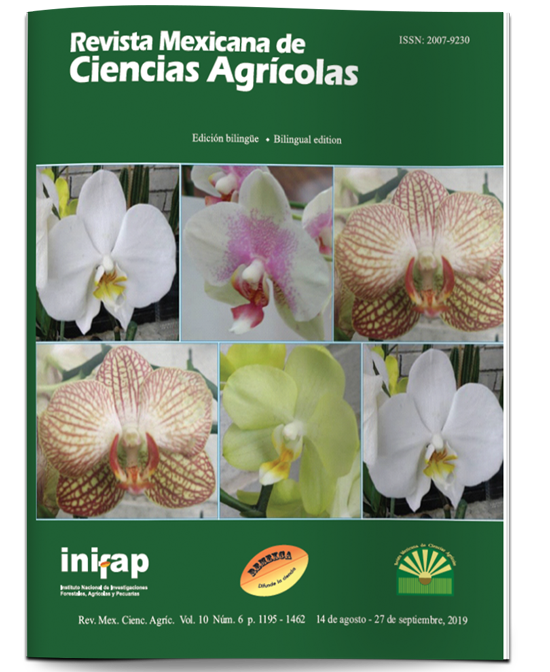Agronomic and physiological behavior of maize native to southeastern Mexico
DOI:
https://doi.org/10.29312/remexca.v10i6.908Keywords:
Zea mays L., creole populations, genetic diversityAbstract
Mexico is the center of origin and domestication of maize (Zea mays L.), in some regions there are still creole populations with the potential to generate improved varieties. The objective of this study was to evaluate the agronomic and physiological behavior of twelve maize populations native to southeastern Mexico. The experiment was carried out in Tizimín, Yucatán in 2017. 32 parameters corresponding to vegetative, phenological, agronomic and physiological variables were evaluated. The results showed a difference of 75 cm between the lower plants (Xn-69) and those of higher bearing (CNB), the plants of the population DZ-252 presented greater foliage (19.1 leaves) and greater stem diameter (26 mm), the earliest populations were CM and CCB (65.5 and 65.8 days, respectively). 58% of the populations evaluated exceeded the average yield of the region (4.5 t ha-1). The highest yield was obtained by the CM, Cro, H1 and SP2015 populations (117.7, 105.8, 111.5 and 109.5 g plant-1, respectively). The populations CM, DZ2015, Cja and Cro had a higher photosynthetic rate; however, the highest water use efficiency was presented by the DZ-252 and XnQroo populations (8.9 μmol CO2/mmol H2O). The CM population stood out for its performance and precocity, the DZ-252 could be used as fodder for the amount of biomass it generated and the XnQroo should be studied under conditions of water restriction for its efficiency of water use, these three populations should be included in breeding programs.
Downloads
Downloads
Published
How to Cite
Issue
Section
License
The authors who publish in Revista Mexicana de Ciencias Agrícolas accept the following conditions:
In accordance with copyright laws, Revista Mexicana de Ciencias Agrícolas recognizes and respects the authors’ moral right and ownership of property rights which will be transferred to the journal for dissemination in open access. Invariably, all the authors have to sign a letter of transfer of property rights and of originality of the article to Instituto Nacional de Investigaciones Forestales, Agrícolas y Pecuarias (INIFAP) [National Institute of Forestry, Agricultural and Livestock Research]. The author(s) must pay a fee for the reception of articles before proceeding to editorial review.
All the texts published by Revista Mexicana de Ciencias Agrícolas —with no exception— are distributed under a Creative Commons License Attribution-NonCommercial 4.0 International (CC BY-NC 4.0), which allows third parties to use the publication as long as the work’s authorship and its first publication in this journal are mentioned.
The author(s) can enter into independent and additional contractual agreements for the nonexclusive distribution of the version of the article published in Revista Mexicana de Ciencias Agrícolas (for example include it into an institutional repository or publish it in a book) as long as it is clearly and explicitly indicated that the work was published for the first time in Revista Mexicana de Ciencias Agrícolas.
For all the above, the authors shall send the Letter-transfer of Property Rights for the first publication duly filled in and signed by the author(s). This form must be sent as a PDF file to: revista_atm@yahoo.com.mx; cienciasagricola@inifap.gob.mx; remexca2017@gmail.
This work is licensed under a Creative Commons Attribution-Noncommercial 4.0 International license.



